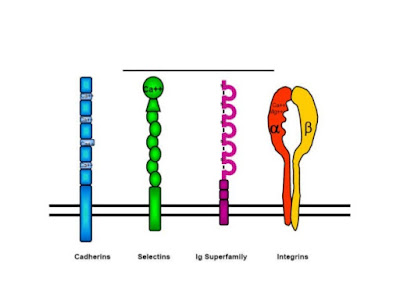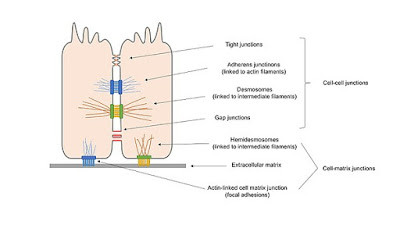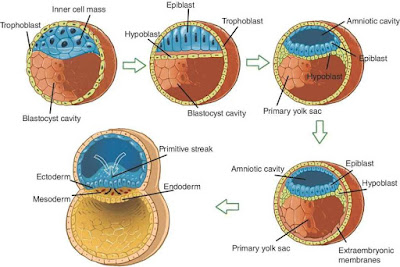Cells adhesion is the process of cells connecting with
each other and with their matrix. This connection happens because of the
existence of cell adhesion molecules (CAMs), which are proteins. (μόρια κυτταρικής προσκόλλησης). Some
important functions that are regulated by cell adhesion include cell migration and
tissue development. If the process of cell
adhesion changes (example : mutation) this can lead to diseases, like cancer.
Cell adhesion
molecules are proteins within the
membrane of the cell and they are classified in two main categories: 1) Molecules dependent on Calcium ions which are Cadherins and
selectins.
2) Molecules non- dependent on calcium ions which are : intergins and immunoglobulin (lg) superfamily.
Cells are able to use different adhesion molecules according to their functions.
Integrins: Are mainly
involved with the interaction of cells with their extracellular substance. Basically
their role is to bind the intracellular cytoskeleton of the cell and the
external substance.
Cadherins : These
molecules bind cells with each other. They are group of transmembrane proteins
dependent on Calcium ions. If Calcium ions are missing cadherins can’t bond
with each other. There are more than 40 different cadherins molecules and many
groups of cells produce different kind of Cadherins. For example : In the previous
article, the basic parts of embryogenesis were explained. During the final
stages, when the neural tube is being formed, a bunch of group cells get
detached from the ectoderm and end up in the mesoderm and create a different cell
line (neural crest cells). This is a party of cells that wants to stop being
connected to one specific group of cells ( the ectoderm cells) and wants to bind
to another cell group (the mesoderm cells). The cadherin molecules that are
binding the ectoderm cells with each other, get ruptured, their bonds are
breaking of, while new cadherin molecules are created between the neural crest
cells in the mesoderm.
Cadhering molecules are categorized based on their unique ability to bind. They
develop homophilic binding ( N-cadherin with N-cadherin). They also, provide a
lot of strength to cells and to the cellular connection of tissues. Once
cadherins are attached to each other the binding site inside the cell, changes Essentially,
the inside part of each protein is attached to the cytoskeleton. The cytoplasmic
part of cadherins connects with actin through intracellular binding proteins ,
known was catenins. (catenin complex).
Celectins : they get
attached to carbohydrates.
Immunoglobulin (lg) superfamily : they are
commonly associated with roles in the immune system.
Cell adhesion molecules create cell junctions.
Cell junctions are essential for cell stability. They are symmetrical structures that are formed, between two adjacent cells. There are three types of cell junction.
Tight-occluding junctions , anchoring junctions and gap junctions.
Anhoring junctions : they are
located above the tight junctions and they have three sub junctions : 1) zonula
adherens or belt desmosome) , 2) macula adgerens or spot desmosome)
and 3) hemidesmosome.
Gap junction: These structures are necessary to
cells, since they give them the ability to create tissues and directly connect the cytoplasm of two cells (cell to cell junction). Gap junctions are composed of transmembrane proteins called connexin
which are organized in groups. They all create a structure of a pore called the
connexon which looks like a channel. Connexons bind to other connexons through
their pores, their proteins bind to each other. This conformation results in
molecules moving from the cytoplasm of one cell to the cytoplasm of another. And
that’s how a tissue is being made, since many cells are able to function are
one.
Tight junctions : Tight-occluding
junctions have a very important function: Τhey determine the polarity of the cells by segregating the basal region from the
apical region. Epithelial cells are polarized, which means that the polarity of
one cell isn’t symmetrical, one half is different from the other.
|
Cell adhesion
molecules |
Many cell
adhesion molecules create cell junctions |
Cell junctions |
|
Anchoring junctions |
Belt desmosomes connects with |
Actine |
|
Cadherins |
|
Tight junctions |
|
Belt desmosome |
Microfibers -actin (through cadherins) |
Part of cytoskeleton |
|
Selectins |
|
Anchoring Junctions |
|
Spot desmosome |
|
|
|
Integrins |
|
Gap Junctions |
|
Hemidesmosome |
|
|
|
immunoglobulin (lg) superfamily |
|
|
|
|
|
|








